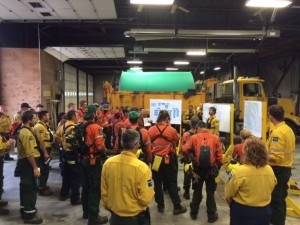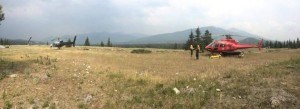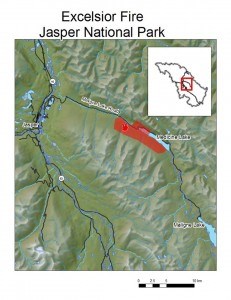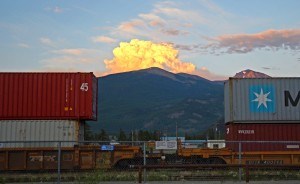
Rain and cooler temperatures continue to help fire crews battle the Excelsior wildfire burning in Maligne Valley, 15 kilometres east of Jasper.
"These favourable weather conditions will allow fire suppression activities to continue today with heli-bucketing and ground crews working to extinguish priority areas of the Excelsior Wildfire," said Parks Canada in a statement published Sunday at 1:30 p.m.
The weather will also expected to reduce smoke and improve overall air quality, although there is still potential for localized smoke because the fire is still burning.
On Saturday, Parks Canada revised the size of the wildfire to 1,000 hectares, down from an earlier estimate of 5,000 hectares.
"Until now, due to smoke and extreme fire behaviour, visibility was too poor for mapping and the fire was estimated at 5,000 hectares," said Parks Canada in a statement published Saturday night at 8 p.m.
"It is not uncommon for estimates to be higher as they are based on straight lines and geographical features."
Overnight rain on Friday night slowed the spread of the wildfire burning near Medicine Lake, allowing fire crews to directly attack the fire from the ground for the first time on Saturday.
"We received between four and six millimetres of rain yesterday evening and overnight, so this continued to slow fire behaviour," said said Kim Weir, fire communications officer for Jasper National Park during a teleconference call Saturday afternoon.
"What this means is this will now provide us an opportunity to attack the fire directly," she said, explaining it is now safe enough to have crews working on the ground and helicopters bucketing water to establish a perimeter around the fire.
The fire was first reported on Thursday around 3:30 p.m.
“Right now there are no people or facilities at threat or at risk," said Weir.
On Friday, resident and visitors in Jasper woke up to a blanket of smoke making it difficult to see nearby mountains. By Saturday the smoke had begun to dissipate and by Sunday the mountains were again visible.

The Municipality of Jasper advises anyone experiencing respiratory discomfort to visit the Seton Healthcare Centre.
Approximately 1,000 people were evacuated from the Maligne Valley over the course of July 9 and 10, including 57 people who were evacuated from the Skyline Trail, one person from the Jacques Lake Trail and 19 people out of the backcountry on Maligne Lake, said Weir.
"That number also includes very popular sightseeing areas and the very popular day hiking areas," she Weir, adding everyone has been accounted for and Parks is continuing to do sweeps of the feeder trails of the Skyline to ensure no one has been left behind.
"There was no panic amongst the evacuees and they either walked out on their own after chatting with us, got a helicopter ride or some of them came out on quad, if that was appropriate. Everything went extremely smoothly," said Weir.
Until Saturday, the fire was being fought from the air with five helicopters because it was not yet safe to put firefighters on the ground. On Saturday, a crew of 20 firefighters arrived from Ontario and another 20 were expected to arrive on Sunday.
Prior to that, Parks had three crews working on the fire, two from Jasper and another from Kootenay and Yoho national parks. Each crew had four people. One is on standby as an initial attack crew, in case of a new wildfire breaking out.
As fire crews work to contain and extinguish the fire, the Maligne Valley is closed, beginning from the base of Maligne Lake Road.
There is no timeframe for when the valley will reopen.
"That depends largely on Mother Nature and how much help we get from her," said Weir.
"We would only open it if, and only if, we determined it 100 per cent safe for people to be in that area in the Maligne Valley, as well as to drive the road down to the Maligne Valley. There's a number of factors we'd need to consider, just one of which is the wildfire burning fire on the landscape.
As a precaution, Parks has set up sprinklers at Maligne Lake, Maligne Canyon, Maligne Hostel and Shangrila Cabin. However, no facilities are at risk at this time.
Due to extreme fire danger, a fire ban has also been issued for all of the Mountain National Parks.

Curtis Germaine, a summer student from Grande Cache, was with four friends swimming in a lake about halfway along the Skyline Trail and a kilometre from their campsite when they first saw the smoke, Thursday.
"We didn't think anything of it and then the helicopter started flying around and eventually landed and a Park Warden told us we had to evacuate."
The men had already set up camp for the night at Curator campground, where another 13 people were also camping.
"It didn't really feel real," said Germaine, adding his group quickly packed up its site. People were evacuated in groups of five.
At first Germaine was told there wasn't enough room for his bag, but on a subsequent trip it was picked up by a helicopter and returned to him.
He said he never felt frighten and he thanked everyone involved in the rescue.
"These guys have been wonderful here," said Germaine, in reference to the staff at the evacuation centre.
"Overall it was a cool experience that I think we will always remember and tell our friends and family about."
The group stayed at the Whistlers campground for the night and said they planned to explore some of the other nearby lakes for the duration of their trip.

"Hopefully one day we will come back and finish the other half of the trail."
At the evacuation centre, located at the community outreach services building, at least 50 evacuees, many with large backpacks, walked through the doors.
Five volunteers helped people sign in, offered them food and drinks and helped them get back to their cars or find them a place to stay for the evening.
"In many ways it's business as usual," said Kathleen Waxer, director of community and family services.
"We thought about what people coming in might require, water, coffee, tea and got organized."
Paul Schmidt, the victim services coordinator, commended everyone in the community for pulling together and said they were kept well informed throughout the entire process.
"Getting people to their vehicles at this end of the Skyline Trail was my first request of the RCMP, and I really appreciate their understanding and our working relationship," said Schmidt.
He also praised Sundog Tours for helping shuttle evacuees from the helicopter to the evacuation centre.
"We likely spent close to $2,500 in assisting in this stressful event, and I have the sense that people really appreciated everything that Community Outreach Services and Jasper Victim Services were doing."
Telsha Knauer and her friend Michelle Yehia were hiking Bald Hills, located at the north end of Maligne Lake, when they were told to evacuate the area.
As they were driving down Maligne Lake Road they came within metres of the fire.
“We opened the windows and it was like opening an oven door,” said Knauer, who lives in Hinton.
“It got really dark really fast. Five more minutes up there and you probably couldn’t see anything.”
Moberly Bridge was temporarily closed, but was reopened to allow guests and employees access to the Fairmont Jasper Park Lodge. Maligne Lake Road, Maligne Canyon Hostel and Jacques Lake Trail remain closed.
“There’s currently no risk from what we understand to Jasper or Jasper Park Lodge,” said Ken Hall, general manger for the Fairmont Jasper Park Lodge.
“At this point we’re in communication with Parks Canada who are updating us as required.”

Parks suspects the fire was caused by a lightning strike that has been smouldering underground since the strike and the recent hot, dry conditions brought it to life.
All park facilities, including campgrounds, are open.
Plumes of smoke from JNP could be seen from Hinton and Edson, according Alberta Wildfire Management.
For more information on what do during an evacuation click here.
Stay tuned to the Fitzhugh’s Facebook and Twitter feeds as this story develops.
Paul Clarke and Nicole Veerman
[email protected]
[email protected]
